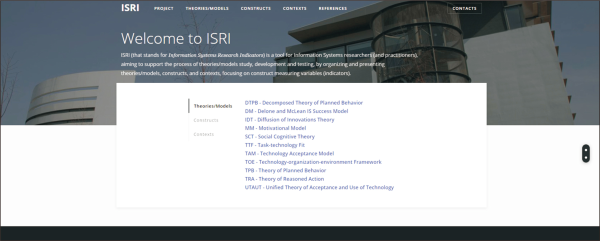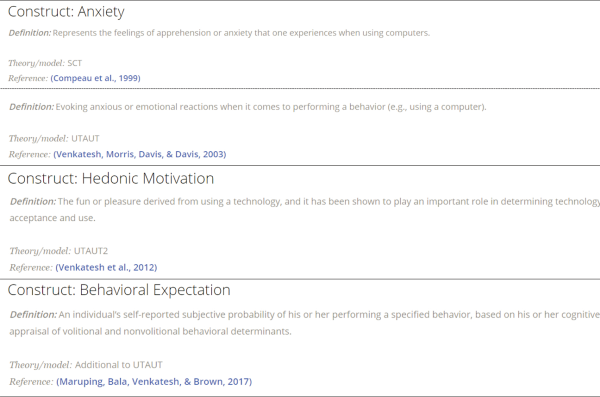1. INTRODUCTION
Information Technology (IT) and Information Systems (IS) play a central role in organizations, making it almost impossible to find an organization that does not use them. In fact, it is well accepted and somewhat consensual that IT/IS are fundamental for the development of virtually any human organization (Varajão, 2018). For instance, digitalization is one of the major trends changing business and society (Kääriäinen et al., 2020). Thus, successfully introducing new IT applications into companies is critical for developing business capabilities, contributing to organizations’ competitiveness, efficiency, and profits (Patnayakuni & Ruppel, 2010; Varajão & Trigo, 2016).
Technology adoption and use theories/models seek to explain users’ acceptance of new technologies and their intention to use them. In the context of IT/IS adoption, several models and theories have been applied, proposed, and developed, identifying aspects that influence the use and success of IT/IS, such as: DeLone and McLean’s IS Success Model (D&M ISS) (DeLone & McLean, 2003, 2016); Task-Technology Fit (TTF) (Dishaw & Strong, 1999; Goodhue & Thompson, 1995); Technology Acceptance Model (TAM) (Davis, 1986); Technology-Organization-Environment Framework (TOE) (Tornatzky & Fleischer, 1990); or the Unified Theory of Acceptance and Use of Technology (UTAUT) (Venkatesh et al., 2003), to mention a few.
It is common for these theories/models to have a high level of abstraction without restricting or detailing the measuring of the constructs that make them up, so they can be applied in several contexts. As researchers test models and theories, constructs (latent variables) are defined differently depending on the object under study (or the researchers’ perspectives), making general characterization difficult, and resulting in a large quantity and diversity of indicators (measuring variables) for the same constructs. Therefore, when researchers need to define indicators for their theoretical models’ constructs, it takes a long time to analyze the literature and identify references that better describe them.
For example, concerning the construct “Accuracy,” different authors have used similar but different indicators (measurement variables) to represent it. Wixom and Todd (2005) define it as “represent[ing] the user’s perception that the information is correct” and use the indicators: “the system produces correct information”; “there are few errors in the information I obtain from the system”; and “the information provided by the system is accurate.” However, Yao and Murphy (2007) define it as “refer[ring] to the degree of correctness of the system” and use the following indicators to evaluate it: “the system will improve the efficiency”; “the system will reduce the incidence of errors when transferring data”; and “the system will reduce the incidence of errors.”
No tool was found to support/help researchers develop IS theories (focusing on constructs and measuring variables). Such a tool would assist researchers’ work when defining constructs and respective indicators, avoiding the need for extensive literature reviews (at least at the first phases of the research projects). To help fulfil this gap, this research aims to present the design, development, and features of a new Web tool named ISRI, which stands for “Information Systems Research Indicators.” This tool should be viewed as an accelerator of the research process by facilitating the identification of relevant literature and the definition of constructs and respective indicators (measurement variables).
The paper is organized as follows: The next section presents the research and development method; section three presents a brief literature review on some of the most used theories/models; section four presents the results of the research work, the ISRI Web tool, and examples for using it in practice; and finally, section five explains the implications of using ISRI for research, as well as limitations and highlights for future research.
2. METHOD
There were two main phases for developing ISRI, as shown in Fig. 1. The first one is related to a systematic literature review and the creation of the ISRI database. The second one is associated with the software development project for creating ISRI (to make available information about the theories/models gathered in the first stage).
2.1. Phase I
The first phase included a systematic literature review aiming to identify models and theories related to IT/IS adoption. Two databases were used: Elsevier’s Scopus and Clarivate Analytics’ (formerly Thomson-Reuters) Web of Science (WoS). From this first review, 103 theories/models were identified. A second search was then performed, focused on those models and theories, to determine the studies that used each theory/model. The selected articles were published in renowned journals in the IS field, such as European Journal of Information Systems, Information Systems Journal, Information Systems Research, Journal of the Association for Information Systems, Journal of Information Technology, Journal of Management Information Systems, Journal of Strategic Information Systems, and MIS Quarterly. Articles from conferences such as the Americas Conference on Information Systems (AMCIS), European Conference on Information Systems (ECIS), International Conference on Information Systems (ICIS), and Pacific Asia Conference on Information Systems (PACIS) have also been considered. With the information gathered, aiming to select the final theories/models for further study, it was decided to consider only those that presented a unique number of results higher than five. It enabled focusing the research on a total of eleven selected theories/models presented next.
The references were selected based on an initial analysis of the title and the abstract of the articles. Whenever the title and abstract were not sufficiently clear, general reading of the article was carried out to check if it contained the requested information. In the process of selection of articles, the following criteria were considered: focus on IT/IS adoption; use of the theories/models selected; definition of the constructs that make up the theories/models; and description of the measurement variables (indicators) of the constructs. Only articles related to the adoption, implementation, use, and acceptance of IT/IS were considered. Overall, articles that used the selected theories/models or used a theory/model resulting from the combination of at least one of the theories/models under study were considered. Articles or books where the theories/models were initially proposed were also taken into account; however, it was in a few cases impossible to access the original document.
In total, about 580 references were selected for collecting the measuring variables (indicators). The indicators identified in the articles were compiled, resulting in the database that can be consulted in ISRI.
2.2. Phase II
ISRI is being designed and developed at the University of Minho by a small team of researchers with extensive experience in IS development and project management, both in academic and industry environments. The development of the Web tool followed the typical steps of software development and related activities, namely: the specification of the software, for defining the expected tool functionalities; the design and implementation of the software, to comply with the specification; validation of the software, to test and verify that the software performs as expected and meets the expectations of the users; and the maintenance/evolution of the software, to support future needs (Sommerville, 2007).
Fig. 2 presents the functional (A) and domain models (B) defined for the project. As shown in the functional diagram (see Fig. 2A), ISRI allows users to search the theories/models, constructs, contexts, and references that support the information in the database. ISRI enables, after selecting a theory/model, viewing detailed information on the associated theory/model, such as the description, the graphical representation (diagram), the constructs, the contexts, and the related construct indicators. If the user needs to view information related to a construct or context, s/he can select it and is then presented detailed information. Regarding the domain model (see Fig. 2B), it has five classes. The main class is “TheoryModel,” which represents each model/theory and, in this application context, it is understood as an aggregation of “Constructs” (latent variables). In turn, the “Construct” class is an aggregation of “Indicators” (i.e., measuring variables). The class “Indicator” is associated with the class “Reference,” since the same indicator can be found in several references, and the same reference typically identifies several indicators. Finally, the “Context” class regards the contexts (e.g., “employee portal,” “ERP,” etc.) where each “TheoryModel” (theories/models) has been applied. ISRI has been developed using the PHP programming language, HTML 5, CSS, JavaScript, and MySQL database server.
3. THEORIES/MODELS FOR ADOPTION AND USE
The theories/models selected in the literature review are presented next in alphabetical order, as they appear in the ISRI: Decomposed Theory of Planned Behavior (DTPB) (Taylor & Todd, 1995b); D&M ISS (DeLone & McLean, 2003, 2016); Diffusion of Innovations Theory (DOI) (Rogers, 1962, 2003); Motivational Model (MM) (Davis et al., 1992); Social Cognitive Theory (SCT) (Bandura, 1986); TTF (Dishaw & Strong, 1999; Goodhue & Thompson, 1995); TAM (Davis, 1986); TOE (Tornatzky & Fleischer, 1990); Theory of Planned Behavior (TPB) (Ajzen, 1985, 1991); Theory of Reasoned Action (TRA) (Fishbein & Ajzen, 1975); and the UTAUT (Venkatesh et al., 2003). For each theory/model, a brief description is presented. A more detailed description of each theory/model, including constructs, indicators, contexts, and diagram, is available in ISRI and respective sources.
3.1. Decomposed Theory of Planned Behavior
The DTPB, proposed by Taylor and Todd (1995b), consists of a decomposition of TPB (Ajzen, 1991). This theory was proposed to represent better the relationships between belief structures and antecedents of intention (Taylor & Todd, 1995b). The decomposition made to TPB (Ajzen, 1991) focused on the Attitude, Subjective Norm, and Perceived Behavioral Control constructs. According to Taylor and Todd (1995b), the decomposition of beliefs has advantages, such as clarifying and improving the understanding of existing relationships, providing beliefs that can be used in different contexts. The model becomes administratively relevant by focusing on specific beliefs, pointing to specific factors that may influence adoption and use. These factors can be worked through system design and implementation strategies.
3.2. DeLone and McLean IS Success Model
The D&M ISS, proposed by DeLone and McLean (2003), is based on theoretical and empirical research in IS, conducted by several researchers between 1981 and 1990 (DeLone & McLean, 2016). According to DeLone and McLean (1992), the D&M ISS was proposed as a framework and model to conceptualize and operationalize IS success. In 2003, the authors proposed an update to the model, becoming known as the Updated D&M ISS. This update emerged after the authors reviewed the various contributions on the success of IS over the previous decade, focusing essentially on research efforts that applied, validated, challenged, and proposed improvements to the original model (DeLone & McLean, 2003).
3.3. Diffusion of Innovations Theory
The DOI was founded in sociology and popularized by Rogers (1962, 1983, 1995, 2003). Rogers synthesized many studies in diffusion from fields that influenced the theory, including anthropology, early sociology, rural sociology, education, industrial sociology, and medical sociology. With the synthesis accomplished, Rogers produced a theory of the adoption of innovations between individuals and organizations (Rogers, 1962).
3.4. Motivational Model
The MM was presented by Davis et al. (1992) in the context of the use of technology. The MM theorizes that extrinsic and intrinsic motivation are the main drivers of an individual’s intention to perform a given behavior, and the intention to perform a behavior is a construct that is closely linked to the actual behavior (Venkatesh & Speier, 1999). Davis et al. (1992) argue that people’s intentions to use computers in the workplace are influenced mainly by their perception of how useful computers are to improve their work performance, and secondarily by the degree of pleasure they have in using the computers themselves.
3.5. Social Cognitive Theory
The SCT, founded in psychology, is a theory that provides a framework for understanding, predicting, and changing human behavior (Bandura, 1986). This theory was proposed by Bandura (1986), and it was first named Social Learning Theory. The SCT states that human functioning is the product of reciprocal interactions of intrapersonal, behavioral, and environmental determinants (Bandura, 1986, 2012). Subsequently, Compeau and Higgins (1995) applied and extended SCT to the context of computer use. However, the nature of the model and the underlying theory allow it to be extended to the acceptance and use of IT in general (Venkatesh et al., 2003). This model proposes the use of several constructs, such as self-efficacy, anxiety, outcome expectations (usefulness), and affects (attitude toward using technology) (Rana & Dwivedi, 2015). According to Compeau and Higgins (1995), encouragement by others, the others’ use, and organizational support in computer use, influence computer self-efficacy and outcome expectations. Computer self-efficacy influences usage directly as well as indirectly through outcome expectations, affect, and anxiety. Outcome expectations influence usage directly as well as indirectly through affect. Finally, affect and anxiety are influential in usage.
3.6. Task-Technology Fit
The TTF, proposed by Goodhue and Thompson (1995), states that user use and attitude towards technology impact individual performance. According to Dishaw and Strong (1999), the TFF model attempts to solve one of the TAM’s main weaknesses concerning the understanding of IT use. The weakness in question is the lack of focus on the task, since IT is the tool that the user uses to carry out their tasks. This weakness contributed to the variety in the results of IT evaluations (Goodhue & Thompson, 1995). Although TAM’s concept of utility is focused on tasks, the addition of more task features could provide a better model for IT use (D’Ambra et al., 2013). According to Dishaw and Strong (1999), the TTF focuses on the correspondence between the user’s task needs and the available IT functionalities. Goodhue and Thompson (1995) proposed the Technology-to-Performance Chain, where IT characteristics, tasks, and individual users explain the use of the information system and individual performance.
3.7. Technology Acceptance Model
The TAM was initially presented by Davis (1986) while conducting doctoral thesis work. This model is an adaptation of Theory TRA (Ajzen & Fishbein, 1980; Fishbein & Ajzen, 1975), where the main objective is to explain the behavior of the use of IS (Davis et al., 1989). Later in 1989, with the work developed by Davis et al. (1989), the TAM was finally conceptualized, gaining visibility. The TAM intends to explain computer system users’ behavior, claiming that the use of the computer system depends directly on the individual’s intention in using it. TAM refers to Behavioral Intention to Use, which results from the influence of the user’s Attitude Toward Using and Perceived Usefulness. As a result, Attitude Toward Using is influenced by two essential factors, Perceived Usefulness and Perceived Ease of Use. Davis (1986) consider that the Perceived Ease of Use can also affect the Perceived Usefulness of the system, while External Variables influence both. The most current version is TAM 3, which presents a complete nomological network (integrated model) of the determinants of IT adoption by individuals (Venkatesh & Bala, 2008).
3.8. Technology-Organization-Environment Framework
The TOE Framework was developed by Tornatzky and Fleischer (1990) and is consistent with the DOI (Rogers, 1983). The TOE framework proved to be useful for studying the adoption and assimilation of different IT innovation types (Oliveira & Martins, 2010). The TOE is a useful and adaptive framework to explain adoption behavior concerning three types of technological innovations, namely applied innovations for technical tasks, innovations for business administration, and innovations embedded in the core business processes of an organization (Ramdani & Kawalek, 2007; Swanson, 1994). The TOE framework identifies three aspects of an organization’s context that influence adopting and implementing a technological innovation, namely technological context, organizational context, and external environmental context.
3.9. Theory of Planned Behavior
The TPB proposed by Ajzen (1985, 1991) is an extension of the TRA (Ajzen & Fishbein, 1980; Fishbein & Ajzen, 1975), made necessary from the limitations of the original model in dealing with behaviors over which people have incomplete volitional control (Ajzen, 1991). The TPB proposes that the intention of an individual to have a given behavior can be explained with precision by the attitude that the individual has to the behavior, by a set of subjective norms, and by the perception about the control of the behavior by the individual (Ajzen, 1991).
3.10. Theory of Reasoned Action
The TRA came from the social psychology area and was proposed by Fishbein and Ajzen (1975). TRA is one of the most fundamental and influential theories of human behavior (Venkatesh et al., 2003), where the objective is to investigate the relationship between attitude and behavior based on two main concepts, principles of compatibility and behavioral intention (Fishbein & Ajzen, 1975; Mishra et al., 2014). According to TRA, the individual’s performance in a particular behavior is determined by his or her Behavioral Intention to perform the behavior, and that Behavioral Intention is determined jointly by the person’s Attitude Towards Behavior and Subjective Norm on the behavior in question. TRA is not especially related to the use of IT. However, the use of IT is a special case of general behavior. Thus, it is easy to understand why TRA underlies theories such as TAM or UTAUT.
3.11. Unified Theory of Acceptance and Use of Technology
The UTAUT, proposed by Venkatesh et al. (2003), was formulated through a combination of eight models of IT acceptance research, including TRA, TAM, MM, TPB, a model combining the TAM and TPB (Taylor & Todd, 1995c), Model of PC Utilization (Thompson et al., 1991), DOI, and SCT. According to Venkatesh et al. (2003), Performance Expectancy, Effort Expectancy, and Social Influence were formulated to influence Behavioral Intention in the use of technology, while Behavioral Intention and Facilitating Conditions determine Use Behavior. Individual difference variables such as Age, Gender, Experience, and Voluntariness of Use were also formulated to moderate the various relationships in UTAUT.
4. RESULTS
4.1. Overview of the User Interface
ISRI aims to support IS researchers in the process of theories/models’ study, development, and testing, by organizing and presenting theories/models, constructs, and contexts, focusing on the constructs’ measuring variables (indicators). In ISRI designing, care was taken to assure that it is intuitive and easy to use. In this sense, all the information in ISRI can be accessed from the initial homepage, as presented in Fig. 3.
ISRI has a navigation menu at the top that allows the user to access the perspectives by which s/he wants to search the database, namely: theories/models, constructs, contexts, or references. The main page also has a menu in the center with the main search perspectives (theories/models, constructs, and contexts). When the user clicks on one of these perspectives, s/he will see on the right side the elements related to them. By clicking the theories/models option, the user is taken to the theories/models page, being presented the list of options available, which currently has eleven theories/models. After selecting the required theory/model, the user is taken to the respective web page. This page has a menu that enables access to the main aspects of the theory/model, namely the description, the graphical diagram, the constructs, contexts of use, and the indicators by construct, as exemplified in Fig. 4.
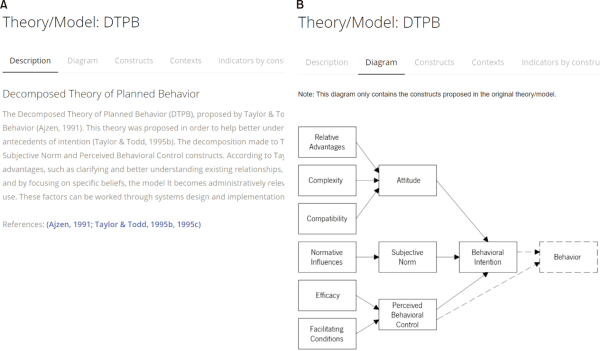
Example of theory/model description (A) and corresponding diagram (B) in ISRI (Information Systems Research Indicators).
Fig. 4A shows the description of a selected model and the respective references. In this example, the model shown is the DTPB. By clicking on the “Diagram” tab, the user has access to the diagram of the model (Fig. 4B). The diagram provides a visual overview of the theory/model. By clicking on the “Constructs” tab, the user has access to the list of all the constructs of the selected model (Fig. 5). For instance, in the case of DTPB, the model has 30 associated constructs which are (see isri.sciencesphere.org): Attitude; Availability; Behavioral Intention; Behavioral Intention for Continued Use; Collaborative Norms; Compatibility; Complexity; Ease of Use; Efficacy; Facilitating Conditions; Facilitating Conditions (Resources); Facilitating Conditions (Technology); Family, Relatives, Friends, and Peer Influence; Future Obligation; Governmental Influence; Hedonic Outcomes; Normative Influences; Peer Influence; Perceived Behavioral Control; Perceived Ease of Use; Perceived Usefulness; Personal Network Exposure; Relative Advantage; Seeker Knowledge Growth; Self-Efficacy; Subjective Norm; Superior’s Influence; Usage; and Utilitarian Outcomes. Please note that it includes constructs from the original model and the extended models/references that applied to the original model and added new constructs.
It is possible for each construct to find several definitions, as presented by different authors, as well as the list of associated indicators. For each indicator listed for a given construct, there is shown the text related to the indicator (the original question that was asked), the scale used to measure that indicator, the context in which it was used, and the respective references. Fig. 6 shows an example of the construct “Complexity.”
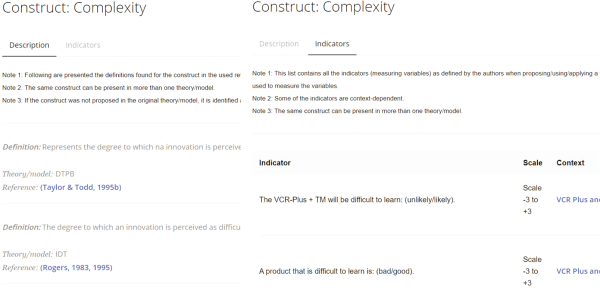
Example of a selected construct description and associated indicators (measuring variables) in ISRI (Information Systems Research Indicators).
By clicking on the “Contexts” tab (see Fig. 4), the user has access to contexts in which the model has already been applied. This perspective in ISRI is important to identify the theories/models already used to study specific contexts. In the case of the DTPB model in Fig. 7, it is noticeable that it has already been used in the following contexts: Computing Resource Center; Electronic Knowledge Repository; Internet TV; and VCR Plus and TM. A significant advantage of this perspective is the possibility of analyzing the similarities and differences in the definitions of the constructs when the theories/models have been applied in different contexts. On the other hand, it is also possible to verify differences, sometimes significant, even when theories/models are applied to the same contexts.
Returning to the main menu (Fig. 3) it is possible, as previously mentioned, to search ISRI for the other two perspectives: constructs and contexts. According to the selected perspective, a list of all available items will appear (by clicking on “Constructs” or “Contexts”). For instance, the user may want to check if a theory/model has already been applied in a given context (e.g., e-Government). There is also the last tab, the one for references, where it is possible to list, in full, all the used references.
4.2. Demonstration
For demonstration purposes, we first searched the Scopus search engine, looking for papers that had in the title (or abstract) the name of any of the models available on ISRI (e.g., “Technology Acceptance Model”). The idea was to find good examples for using ISRI (i.e., where ISRI could have contributed to the initial development of the presented theory/model). From the results obtained, two papers were selected since they present the theory/model, the constructs and indicators used, and were applied in two different contexts. The first selected paper, entitled “Student acceptance of virtual laboratory and practical work: An extension of the technology acceptance model” (Estriegana et al., 2019), uses TAM in the context of e-learning. The second one, entitled “Factors influencing the adoption of mHealth services in a developing country: A patient-centric study” (Alam et al., 2020), uses the UTAUT model in the context of mobile computing. Please note that these two papers were randomly selected for illustrative purposes and do not relate to this work or ISRI.
4.2.1. An example regarding the paper “Student acceptance of virtual laboratory and practical work: An extension of the technology acceptance model”
The paper of Estriegana et al. (2019) presents the results of an empirical survey study whose purpose was to examine students’ acceptance of technology and the process of adopting an online learning environment incorporating Web-based resources, such as virtual laboratories, interactive activities, and educational videos, and a game-based learning methodology using TAM.
Suppose the authors had chosen to conduct their study with the help of ISRI. In that case, they could have started their research by selecting the context, which is the IT adoption associated with e-learning. After selecting the context, the researchers would have access to the available constructs, which in this case are the constructs associated with the TAM model (as can be found at isri.sciencesphere.org): Attitude Towards Use; Computer Self-efficacy; Intention to Use; Perceived Ease of Use; Perceived Enjoyment; Perceived Usefulness; Actual Usage; Cognitive Absorption; Content Quality; External Influence; Internet Self-efficacy; Interpersonal Influence; Learning Goal Orientation; Network Externality; Perceived Performance; System Functionality; System Interactivity; and System Response. In ISRI, for each construct, there are available indicators reported in the literature to measure it. For example, the indicators associated with the first construct, Attitude Towards Use, are presented in Fig. 8.
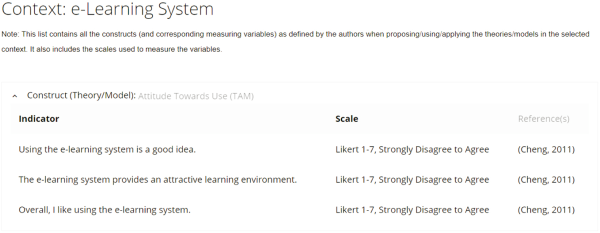
Indicators (measuring variables) available in ISRI (Information Systems Research Indicators), related to the construct Attitude Towards Use in the e-Learning System context.
Following this, considering the model of their study (TAM), the authors could have identified the indicators of all the constructs available in ISRI: Attitude Toward Using; Behavioral Intention to Use; Efficiency; Perceived Ease of Use; Perceived Usefulness; Playfulness; and a new construct, Perceived Satisfaction. Although the work developed by the authors may involve other references than those available at ISRI, the use of ISRI is useful in the identification of an initial version of the model to fasten the research process.
4.2.2. An example regarding the paper “Factors influencing the adoption of mHealth services in a developing country: A patient-centric study”
The objective of Alam et al. (2020) was to study the adoption of mHealth services in a developing country using the UTAUT model. In this case, mHealth services are defined as “medical and public health practices supported by mobile devices, such as mobile phones, that are used to make decisions and provide emergency care and, among other benefits, that help the elderly to manage their daily activities associated with independent living.”
As in the previous example, if the authors had started their research by searching ISRI by context, in this case the use of mobile devices in health, they would have found that a possible model for their study is the UTAUT model. Although there is no “mHealth” context in ISRI, there are four contexts associated with mobile devices/services (i.e., Mobile Business [m-business], Mobile Devices, Mobile Internet, and Mobile Technologies). There are 55 constructs related to the UTAUT model in ISRI, and researchers can view details on the indicators for each construct. The work done by the authors identifies the following constructs (Alam et al., 2020): Performance Expectancy; Effort Expectancy; Social Influence; Facilitating Condition; Perceived Reliability; Price Value; Gender; Behavioral Intention; and Actual Use Behavior, which are all available in ISRI. When comparing the indicators that the authors of this second paper have chosen to measure the constructs (e.g., Behavioral Intention construct) to the ones returned by ISRI, it turns out that they are similar, as it is possible to see in Table 1.
Since all the authors’ constructs/indicators to perform their work are available on ISRI (with the appropriate adaptations), ISRI could also have been very useful in this context.
One can argue that both presented examples were successfully developed without the need for ISRI. This is a fact; however, the purpose of ISRI is not to replace the researchers or the literature review process. On the contrary, it aims to support that work by making the process easier and more straightforward.
4.2.3. Hypothetical example
This section presents an example of the use of ISRI based on a hypothetical example. The aim is to describe a case of using ISRI in the first stages of the research work.
Suppose that a new theoretical model like the one presented in Fig. 9 must be developed.
The model has three constructs (Anxiety, Hedonic motivation, and Behavioral Expectation). ISRI can help develop this model in several aspects: 1) Definition of constructs; 2) Identification of measuring variables/indicators; 3) Identification of the relevant literature.
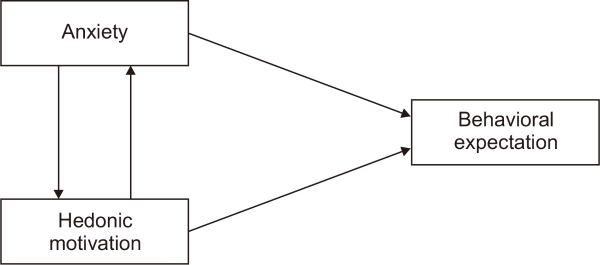
Definitions available in ISRI (Information Systems Research Indicators) for the selected constructs.
Regarding the definition of constructs, by selecting the “Constructs” perspective, the user obtains the list of constructs and respective definitions, as it is possible to verify in Fig. 10.
Regarding the identification of measuring variables (indicators), by selecting each construct, the user can go to the “Indicators” tab and obtain the available indicators in ISRI, which are: for Anxiety: “I feel apprehensive about using [a] computer”; “It scares me to think that I could cause the computer to destroy a large amount of information by hitting the wrong key”; “I hesitate to use a computer for fear of making mistakes I cannot correct”; “Computers are somewhat intimidating to me”; “I feel apprehensive about using the system”; “It scares me to think that I could lose a lot of information using the system by hitting the wrong key”; “I hesitate to use the system for fear of making mistakes I cannot correct”; and “The system is somewhat intimidating to me”; for Hedonic Motivation: “Using mobile Internet is fun”; “Using mobile Internet is enjoyable”; and “Using mobile Internet is very entertaining”; and for Behavioral Expectation: “I expect to use the system in the next -n- months”; “I will use the system in the next -n- months”; and “I am likely to use the system in the next -n- months.”
Fig. 11 provides an extract of the indicators identified above, organized by construct. As shown in the figure, for each indicator is available: the description of the indicator; the measuring scale; the context and the theory/model in which it was used; and the respective references.

Sample of available indicators (measuring variables) in ISRI (Information Systems Research Indicators) for the constructs Anxiety, Hedonic Motivation and Behavioral Expectation (see isri.sciencesphere.org).
Finally, the user can access the full references related to the constructs/indicators by clicking on them.
5. DISCUSSION AND FUTURE DEVELOPMENTS
The work presented in this paper addresses a common challenge in research work, which is related to the time consumed in the early stages of the literature review process for defining and developing theories/models (in this case, specifically associated with IS).
There are two main contributions from ISRI. The first one is the ISRI database of theories/models, which resulted from a systematic literature review. Eleven theories/models, over 400 constructs, nearly 2,500 indicators, and about 60 contexts of the application were identified, compiled from 580 references. The second contribution is the ISRI Web tool itself, which quickly and intuitively provides the information stored in the database, allowing researchers to access it from different perspectives: theories/models, constructs, and contexts.
Another contribution of this work is related to providing examples for using ISRI in practice, presented in section four. The first two examples show how two recently published research papers in leading journals could have used ISRI as a source of information to develop the applied models. The third example shows how ISRI can be used to support the development of a new research model.
The main limitation of ISRI is that it is always an ongoing work: The increasing rate of publication of articles in the IT/IS adoption and use topics requires constant updating of the ISRI database. There is also space to expand the tool functionalities, including advanced search features.
Finally, we would like to stress that ISRI is not only a tool to facilitate research. It is also a tool for support learning since it provides students and young researchers with a set of the most applied theories/models and respective sources in IT/IS adoption and use.
As future work, we propose developing new functionalities to be added to ISRI; for instance, regarding the measurement variables (indicators) collection and presentation. It is also suggested to carry out case studies to identify opportunities for further development.
REFERENCES
(1986) PhD thesis Cambridge, MA, USA: Massachusetts Institute of Technology A technology acceptance model for empirically testing new end-user information systems: Theory and results, http://hdl.handle.net/1721.1/15192
, , (1989) User acceptance of computer technology: A comparison of two theoretical models Management Science, 35(8), 982-1003 https://www.jstor.org/stable/2632151?seq=1.
, , , , , (2020) Applying the positioning phase of the digital transformation model in practice for SMEs: Toward systematic development of digitalization International Journal of Information Systems and Project Management, 8(4), 24-43 https://doi.org/10.12821/ijispm080402.
(1994) Information systems innovation among organizations Management Science, 40(9), 1069-1092 https://www.jstor.org/stable/2661474.
, (1995c) Understanding information technology usage: A test of competing models Information Systems Research, 6(2), 144-176 https://www.jstor.org/stable/23011007.
(2018) The many facets of information systems (+projects) success International Journal of Information Systems and Project Management, 6(4), 5-13 https://doi.org/10.12821/ijispm060401.
, (2005) A theoretical integration of user satisfaction and technology acceptance Information Systems Research, 16(1), 85-102 https://www.jstor.org/stable/23015766.


